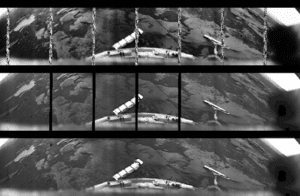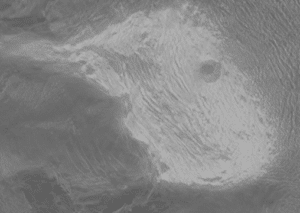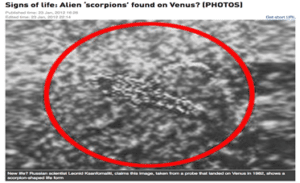By Dr. Raymond A. Keller, a.k.a. the “Cosmic Ray,” author of the international awards-winning Venus Rising trilogy (Headline Books, Terra Alta, West Virginia, 2015-2017)
Why is Lady Gaga depicted with a scorpion in her “Venus” single’s cover art? To find out the amazing answer, go to the end of this article. See also http://gagadaily.com/forums/topic/188509-why-is-there-a-scorpion-on-the-venus-single-cover-art/.
Many Surprises
The photographs of the Venusian surface transmitted back to the Earth by the Soviet Union’s Venera 13 and Venera 14 landing probes provided many surprises. Planetary geologists were expecting to see a sandy desert under a very dim and distorted light. But what turned up in the photographs was a brightly-lit, orange-tinted landscape with jagged rocks strewn all about. In accordance with the findings of American space probes previously sent to our sister planet, as announced by spokespersons of the National Aeronautics and Space Administration (NASA) in the United States, scientists from around the globe were not anticipating such clear, bright pictures. It was even noted that the distant Venusian horizon was plainly visible in the corner imagery from the Venera photographs.
If what the NASA specialists had been telling us all along, that Venus had such an extremely high atmospheric density approaching one hundred times that of the Earth’s, then the Venusian atmosphere would have been found to be as dense as water at a depth of 2,000 feet below sea level. What the Soviet photographs revealed was a rock field on Venus, in the vicinity of the Venera landed craft, showing only moderate signs of erosion. Many were bound to question the prior NASA explanations as they did not jive with the results coming in from the Soviet Union’s dual robotic Venera landing craft. NASA analysts of the previous data gathered on Venus by our Mariner and Pioneer probes had been spouting off about a hot, sand-blown and 800 degrees Fahrenheit Venusian surface, a veritable hell in outer space.
It now became apparent that the Americans’ theories about Venus and conditions there needed a drastic revision, and quickly at that, if NASA was going to retain any shred of scientific credibility in academic circles, let alone be believed by the public at large. Returning to Dr. Hal Masursky of the United States Geological Survey, even he thought the Venera photographs odd, especially after considering all the disinformation NASA had been previously pumping out to the inquisitive masses about the supposedly much higher atmospheric density and dark, hellish surface conditions. Dr. Masursky, America’s leading space geologist at the time, declared that in rummaging through all the Venera photographs, “We could not find the great sand dunes we were expecting. We were surprised by the photos of the rocky plain, clean of soil.”
And in reference to the posited sulfuric rain that was supposed to be constantly descending from the thick, perpetually dark and overcast Venusian cloud banks, Dr. Masursky opined that, “None has been able to explain where such a self-grounding atmosphere these thousands of Earth-like lightning bolts come from.” What was not being stated, however, by Dr. Masursky or anyone else involved with NASA’s Venus programs, was that in the previous year representatives of the Soviet Academy of Sciences had approached American scientists contracted with NASA about where, in their estimation, they should steer the Venera probes for safe landings on the Venusian surface.
1982 photo from Soviet Venera 13 probe with clear Venus skies and mountain range in distance. Semi-disc in foreground is the infamous ejected “lens cap.” See https://www.reddit.com/r/space/comments/6z5vlq/image_from_the_surface_of_venus_taken_by_venera/.
This is a photo taken by the Venera 10 probe in 1975 of variable Venusian terrain, but shot from a 180 degree perspective. To see a straightened out and reprocessed version by Professor Ted Stryk of Roane State Community College in Oak Ridge, Tennessee, a member of the Planetary Society, please go to http://danielmarin.naukas.com/2014/07/23/la-superficie-de-venus-como-nunca-la-visto/. Being a land-owner in Datil, New Mexico, I could readily see similarities in land forms on our sister world. There also appears to be a mountain lake in the distance and possible evidence of moss and other types of vegetation.
Up to that time, this seemed like a rather strange request, especially when one would compare the Soviet Venus exploration program with NASA’s and discover that their achievements in this area, at least, had far surpassed our own. And following the success of the Venera 13 and 14 missions, a team of Soviet scientists was dispatched to the United States, mostly of Russian ethnicity, to share their landing probes’ findings with a consortium of 500 scientists from throughout the Western world. This meeting took place in Houston, Texas, but was closed to the public. So in spite of the economic and political differences that then existed between the two superpowers, it appears as though there was some sort of cooperation between them in the area of concealing information garnered about outer space, but particularly with the planets in our solar system and any signs of life above, on or below their surfaces.
The greatest care was taken by both the Soviet Union and the United States when dealing with any data collected that was pertinent to our sister planet Venus. At the secret Venus confab, the conclusion that Venus was once covered with great oceans was allegedly agreed upon by all those assembled. One scientist spoke up, however, and asked the question everyone else in the hall was thinking but was afraid to voice: “Let us suppose,” proclaimed the one brave scientist, “that Venus still does have oceans; let’s say seventy to eighty percent of its surface is covered by water. This would certainly explain the heavy cloud cover, and the lightning storms.”
Spacecraft Deficiencies Noted
At the Houston conference, a glaring deficiency in both of the Venera spacecraft was noted. An expert on spectroscopy wondered aloud, “Why didn’t the spectrophotometer in both of the Venera register the light dust clouds kicked up by the landing of the spacecraft?” The questioning scientist reasoned that since this important instrument failed to detect even the dust clouds churned up from the surface touchdown of the respective Venera craft, then what other instrumentation may have also failed to function properly?
Orthographic view of Venus topography as centered over North Pole. Photo comes from files of Jet Propulsion Laboratory in Pasadena, California, as taken by Magellan space probe in 1990. White areas at pole and around equator indicate snow-capped mountain ranges. See https://www.jpl.nasa.gov/spaceimages/details.php?id=PIA00007.
Orthographic Projections
Back in May 1982, Astronomy magazine published a fine arrangement of orthographic projections made of the topographies of the Earth, Mars and Venus. Insofar as the Earth was concerned, the photographs were taken from an orbiting satellite passing over the Western Hemisphere where the Andes, the Rocky Mountains and the poles were clearly seen covered in white. This indicated the presence of snow. Mars, too, was cast in white for its polar regions, in addition to various mountainous terrains. And much to the consternation of NASA scientists, who somehow let the release of these photographs pass by the notice of their censors, Venus was also showing expanses of white, and these were numerous. Those whitened areas of Venus included its immense equatorial mountain range that covers half of the entire sphere from East to West. Other white areas of Venus were also found in its North Polar Region.
Of course, NASA administrators could not let this stand; but it took them a whopping 31 years to come up with a tentative explanation, i.e. that on Venus it actually snows metal. Rose Eveleth, a science writer for the SMITHSONIAN.COM website, reported on NASA’s unusual “findings” in its 12 June 2013 issue. Eveleth wrote that NASA’s Venus experts informed her that, “At the very top of Venus’s mountains, beneath the thick clouds, is a layer of snow. But since it’s so hot on Venus, snow as we know it can’t exist. Instead, the snow capped mountains are capped with two types of metal: galena and bismuthinite.”
A NASA spokesperson contended that while the snow on Venus appears to be similar to frost in both its appearance and the way it was created, it really has nothing to do with the water cycle. OK, so it looks like frost and is similarly created; but it isn’t composed of water. The spokesperson continued, declaring that, “On the lower Venusian plains, temperatures reach a searing 480°C (894°F). This is hot enough that reflective pyrite minerals on the planet’s surface are vaporized, entering the atmosphere as a kind of metallic mist, leaving only the dark volcanic rocks like basalt in the Venusian lowlands.”
What puzzled me was that the Soviet Venera landing probes showed no evidence of this “metallic mist” in any of the photographs taken on Venus. Every Venera photograph showed clear, bright skies as far as the camera lens could reach. There was none of this theoretical misting effect actually seen on Venus by the probes sent there of any nation, in real time. In addition, there were no dark volcanic rocks in the lowlands, only in certain areas of the highlands. And neither did the spectrometers detect any of the metals of bismuthinite and galena falling down from the sky in the area or vicinity of any of the higher altitude sites in which the probes had landed. So there’s something askew here; and it only gives further credence to the vast Venus conspiracy that has been foisted upon us for the past 60 years or so.
The NASA spokesperson alleges that, “At higher altitudes, this mist condenses, forming shiny, metallic frost on the tops of the mountains. And Earth’s simmering sibling has plenty of high altitude terrain. Maxwell Montes, the tallest peak on Venus, stands at an altitude of 11 kilometers (6.8 miles) — 3 kilometers (1.8 miles) higher than Mount Everest.”
And NASA seriously wants us to believe that on a mountain 6.8 miles in altitude that searing hot temperatures prevail and that it rains metal from the sky? Talking about science fiction! I, and countless others in the ufology community, have been saying all along that this is pure nonsense. Going beyond NASA and its drab Venus story, let’s move on to what the European Venus Express probe has discovered about the true temperatures, snow and the polar regions of our sister planet.
Santa Claus Right at Home
The truth of the matter is that Santa Claus himself might find it quite comfortable on the North Pole of Venus, where conditions are quite similar to those found on the North Pole of Earth. At least that is what the results of the European Space Agency’s Venus Express probe have revealed. Abigail Beal, a science reporter for the United Kingdom’s Daily Mail newspaper, wrote a series of articles on the real conditions discovered by the European probe in its 22 and 25 April 2016 editions. Some of the conclusions reached by the European scientific team analyzing the data that came in from Venus were that the poles are much colder than anywhere else on Earth and were covered by unusual “atmospheric waves.” In addition, the Venus Express definitively demonstrated that the atmosphere at the poles of Venus was far less dense than anyone had imagined.
Beal wonders why most of the NASA probes sent to Venus supposedly die out after a short duration, while the European probe, much like the Energizer Bunny, continued to transmit important data from Venus. The Venus Express was actually the first Venus exploration mission of the European Space Agency. It was launched in November 2005 and arrived at Venus in April 2006, whence it began continuously sending back science data from its polar orbit around Venus until 16 December 2015, when the mission was officially ended.
The spacecraft was equipped with seven scientific instruments, with the main objective being the long term observation of the Venusian atmosphere. Such a long period of deployment for a planetary probe had never been done in previous missions to Venus, by any nation or consortium of nations, and proved to be the key to a better understanding of the atmospheric dynamics of our sister world. The results from the Venus probe contributed much to our understanding of atmospheric dynamics in general; and might prove useful in helping climatologists get a better grip on atmospheric and climate changes occurring right here on Earth. The spacecraft’s carrier signal was last detected by the European Space Agency’s monitoring station on 18 January 2015. It is believed that at that time the Venus Express had exhausted the last of its propellant. So the Venus Express, while originally intended to conduct a mission lasting only 500 days, spent eight years orbiting the cloudy planet before it ran out of fuel.
Authorities at the European Space Agency held a closed-door session in February 2001 to review discrepancies in the findings of NASA’s Pioneer Venus probe launched in the late 1970s with those garnered by the Soviet Venera probes in the early 1980s. The European Venus Express was given the green light at that meeting for the purpose of discovering the truth about Venus’ atmosphere. They had a sneaking suspicion that the American and the Russian space agencies knew a lot more about Venus than they were letting on. The Venus Express would get to the truth of the matter.
This is the Maxwell Montes region at the North Pole of Venus. Frozen lake clearly seen in the Cleopatra impact crater in the upper east quadrant. See http://www.unmannedspaceflight.com/lofiversion/index.php/t7276.html.
Polar Ice Box
The Venus Express confirmed that the planet was volcanically active and spun in the opposite direction of most planets. So if you were standing on the surface of Venus, you could watch the Sun rise in the West and set in the East. But most remarkable in the probe’s findings was that Venus’ atmosphere is rippling with atmospheric waves, both gravitational and planetary, that serve to cool down the Polar Regions to an average temperature of -157°Celcius, or -250.6° Fahrenheit. This would make Venus’ North and South Polar Regions, both covered by dual vortex systems that generate these atmospheric waves, colder than any location on the Earth. The vortices apparently serve as a planetary air conditioning system.
The European spacecraft observations also indicated that the Venusian atmosphere, at least in the Polar Regions, was much less dense than anyone else had suspected, by a factor of 40%. Dr. Ingo Müller-Wodarg of Imperial College London, United Kingdom, the director of the Venusian atmospheric study, declared that, “These lower densities could be at least partly due to Venus’ polar vortices, which are strong wind systems sitting near the planet’s poles. Atmospheric winds may be making the density structure both more complicated and more interesting!”
That the polar region was also found to be dominated by strong atmospheric waves proved to be very important, for this phenomenon is thought to be vital in shaping all planetary atmospheres, including Earth’s. Another Venus Express project scientist, Dr. Sean Bruinsma of the Centre National D’Etudes Spatiales (National Center for Space Studies) in France, also remarked about this phenomenon, “By studying how the atmospheric densities changed and were perturbed over time, we found two different types of wave: Atmospheric gravity waves and planetary waves.”
Prophetic Science Fiction
Here’s an interesting, but prophetic, excerpt from early science fiction writer, Garrett P. Serviss’ novel about the exploration of Venus, A Columbus of Space (New York: D. Appleton and Company, 1894):
Will an “ice queen” greet future astronauts to Venus?
Photo is from advertisement for Disney on Ice’s “Worlds of Enchantment.” See http://www.kpbs.org/events/2017/jan/29/disney-on-ice-presents-worlds-of-en/?et=72571.
V*E*N*U*S
Suddenly, with the slightest perceptible bump, we touched the soil, and the car came to rest. We had landed on Venus!
“It’s unquestionably, frightfully cold outside,” said Edmund, “and we’ll now put on these things.”
He dragged out of one of his many lockers four suits of thick fur garments, and as many pairs of fur gloves, together with caps and shields for the face, leaving only narrow openings for the eyes. When we had got them on, we looked like so many Eskimo. Finally, Edmund handed each of us a pair of small automatic pistols, telling us to put them where they would be handy in our pockets.
Our preparations being made, we opened the door. The air that rushed in almost hardened us into icicles!
Lady Gaga gets her “scorpion” on: The photo below depicts a scorpion-shaped creature photographed by the rear camera onboard the Venera 13 Soviet Venus probe in 1982. Dr. Leonid Ksanfomaliti, a premier space scientist in the Russian space program, provided a detailed analysis of the Venera photos, taken 30 years previously, to a reporter for a prominent Russian news agency in late January 2012. Of the televised images that came in from the Venus probe, Ksanfomaliti declared, “They all emerge, fluctuate and disappear.” A more thorough account of his findings appeared in the acclaimed Russian science magazine, Solar System Research.
“What if we forget about the current theories about the non-existence of life on Venus, let’s boldly suggest that the objects’ morphological features would allow us to say that they are living,” added the scientist.
One of the bloggers to the Gaga Daily website commented that, “One of the things I love most about Gaga’s song ‘Venus’ is how she intertwines the Greek/Roman mythology with space & planets. So this is perfect, to me!”
Who can disagree? Long live Lady Gaga! -Cosmic Ray








